Antibody data
- Antibody Data
- Antigen structure
- References [1]
- Comments [0]
- Validations
- Immunocytochemistry [2]
- Immunohistochemistry [2]
- Other assay [2]
Submit
Validation data
Reference
Comment
Report error
- Product number
- PA5-104479 - Provider product page

- Provider
- Invitrogen Antibodies
- Product name
- LIGHT Polyclonal Antibody
- Antibody type
- Polyclonal
- Antigen
- Synthetic peptide
- Description
- Antibody detects endogenous levels of total TNFSF14.
- Reactivity
- Human, Mouse
- Host
- Rabbit
- Isotype
- IgG
- Vial size
- 100 μL
- Concentration
- 1 mg/mL
- Storage
- -20°C
Submitted references HES5-mediated repression of LIGHT transcription may contribute to apoptosis in hepatocytes.
Miao X, Guo Y, Zeng S, Liu X, Teng X, Li L, Hong W
Cell death discovery 2021 Oct 23;7(1):308
Cell death discovery 2021 Oct 23;7(1):308
No comments: Submit comment
Supportive validation
- Submitted by
- Invitrogen Antibodies (provider)
- Main image
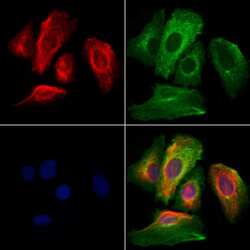
- Experimental details
- Immunofluorescent analysis of LIGHT in HeLa cells. Samples were fixed with paraformaldehyde, permeabilized with 0.1% Triton X-100, blocked with 10% serum (45 min at 25°C), incubated with mouse anti-beta tubulin and LIGHT polyclonal antibody (Product # PA5-104479) using a dilution of 1:200 (1 hr, 37°C), and followed by goat anti-rabbit IgG Alexa Fluor 594 (red) and goat anti-mouse IgG Alexa Fluor 488 (green).
- Submitted by
- Invitrogen Antibodies (provider)
- Main image
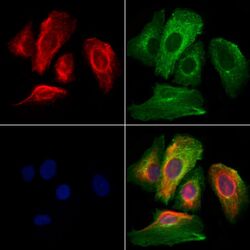
- Experimental details
- Immunofluorescent analysis of LIGHT in HeLa cells. Samples were fixed with paraformaldehyde, permeabilized with 0.1% Triton X-100, blocked with 10% serum (45 min at 25°C), incubated with mouse anti-beta tubulin and LIGHT polyclonal antibody (Product # PA5-104479) using a dilution of 1:200 (1 hr, 37°C), and followed by goat anti-rabbit IgG Alexa Fluor 594 (red) and goat anti-mouse IgG Alexa Fluor 488 (green).
Supportive validation
- Submitted by
- Invitrogen Antibodies (provider)
- Main image
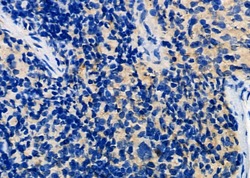
- Experimental details
- Immunohistochemistry analysis of LIGHT in mouse spleen tissue. The sample was formaldehyde fixed and a heat mediated antigen retrieval step in citrate buffer was performed. Samples were incubated with LIGHT polyclonal antibody (Product # PA5-104479) using a dilution of 1:100 (4°C overnight) followed by HRP conjugated anti-Rabbit secondary antibody.
- Submitted by
- Invitrogen Antibodies (provider)
- Main image
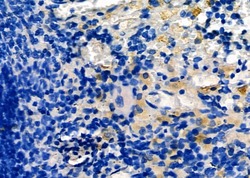
- Experimental details
- Immunohistochemistry analysis of LIGHT in rat spleen tissue. The sample was formaldehyde fixed and a heat mediated antigen retrieval step in citrate buffer was performed. Samples were incubated with LIGHT polyclonal antibody (Product # PA5-104479) using a dilution of 1:100 (4°C overnight) followed by HRP conjugated anti-Rabbit secondary antibody.
Supportive validation
- Submitted by
- Invitrogen Antibodies (provider)
- Main image
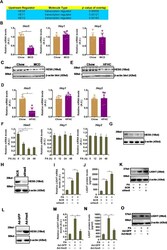
- Experimental details
- Fig. 3 HES5 downregulation parallels LIGHT upregulation in the pathogenesis of non-alcoholic fatty liver disease. A IPA analysis of potential LIGHT upstream regulators. B , C C57B6/L mice were fed an MCD diet for 4 weeks. Hepatic gene expression was examined by qPCR and western. D , E C57B6/L mice were fed an HFHC diet for 12 weeks. Hepatic gene expression was examined by qPCR and western. F , G Primary murine hepatocytes were treated with palmitate (0.3 mM) and harvested at indicated time points. Gene expression was examined by qPCR and ELISA. H - K Primary murine hepatocytes were transfected with siRNA-targeting LIGHT or scrambled siRNA (SCR) followed by treatment with PA (0.3 mM). LIGHT expression was examined by qPCR, ELISA, and western blotting. L - O Primary murine hepatocytes were transduced with Ad-HES5 or Ad-GFP followed by treatment with PA (0.3 mM). LIGHT expression was examined by qPCR, ELISA, and western blotting.
- Submitted by
- Invitrogen Antibodies (provider)
- Main image
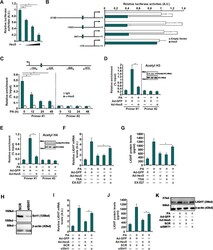
- Experimental details
- Fig. 4 HES5 directly binds to the LIGHT promoter and represses LIGHT transcription. A A LIGHT promoter-luciferase construct (-2186/+1) were transfected into HepG2 cells with or without HEY5. Luciferase activities were normalized by protein concentration and GFP fluorescence. B Different LIGHT promoter-luciferase constructs were transfected into HepG2 cells with or without HES5. Luciferase activities were normalized by protein concentration and GFP fluorescence. C Primary murine hepatocytes were treated with palmitate (0.3 mM) and harvested at indicated time points. ChIP assay was performed with anti-HES5 or IgG. D , E Primary murine hepatocytes were transduced with Ad-HES5 or Ad-GFP followed by treatment with PA (0.3 mM). ChIP assay was performed with anti-acetyl H3 and anti-acetyl H4. Inset, global histone H3/H4 and acetyl H3/H4 levels were examined by western blotting. F , G Primary murine hepatocytes were transduced with Ad-HES5 or Ad-GFP followed by treatment with PA (0.3 mM) in the presence of absence of TSA (100 nM) or EX-527 (1 muM). LIGHT expression was examined by qPCR and ELISA. H-K Primary murine hepatocytes were transduced with Ad-HES5 or Ad-GFP, transfected with siRNA-targeting SIRT1 or scrambled siRNA (SCR) and treated with PA (0.3 mM). SIRT1 knockdown efficiency was examined by western. LIGHT expression was examined by qPCR, ELISA, and western blotting.
 Explore
Explore Validate
Validate Learn
Learn Western blot
Western blot Immunocytochemistry
Immunocytochemistry